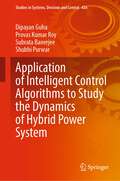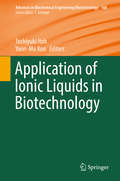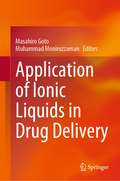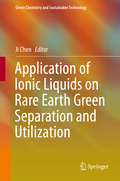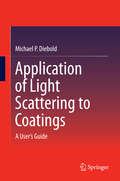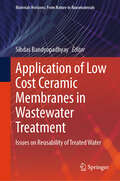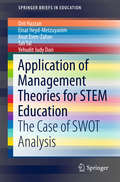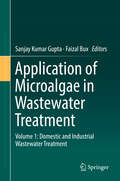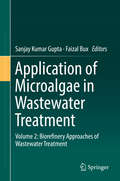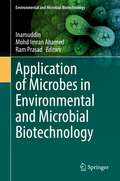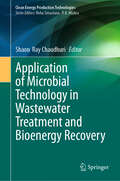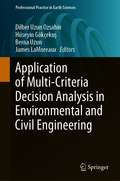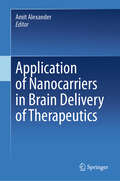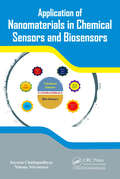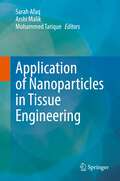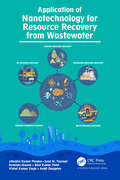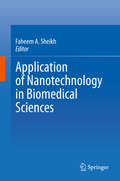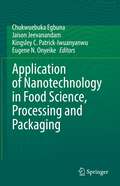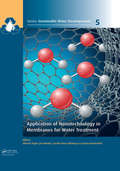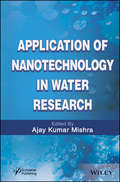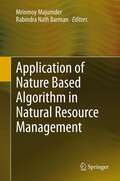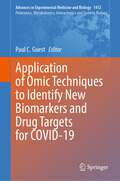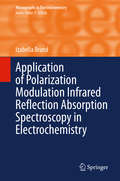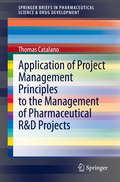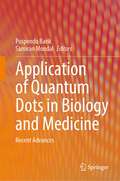- Table View
- List View
Application of Intelligent Control Algorithms to Study the Dynamics of Hybrid Power System (Studies in Systems, Decision and Control #426)
by Dipayan Guha Provas Kumar Roy Subrata Banerjee Shubhi PurwarThis book aims to systematically review and design different intelligent control algorithms for the small-signal stability assessment of HPS. With the growing consciousness of global warming and the fast depletion of natural power generation resources, the existing power system is on the verge of transitions to a “hybrid power system (HPS)” integrated with distributed energy resources. The recent results and requirements for the developments of intelligent control algorithms have motivated the authors to introduce this book for extensively analyzing the performance of HPS against unknown/uncertain disturbances. This book introduces fractional-order resilient control methodologies for arresting small-signal instability of HPS. The prospective investigation has been performed on the MATLAB platform. This book is helpful for undergraduate, postgraduate students, and research scholars working in power system stability, control applications, and soft computing in particular.
Application of Ionic Liquids in Biotechnology (Advances in Biochemical Engineering/Biotechnology #168)
by Toshiyuki Itoh Yoon-Mo KooThis volume explores how ionic liquids are used in different areas of biotechnology. It also provides insights on the interaction of ionic liquids with biomolecules and biomaterials. Ionic liquids have become essential players in the fields of synthesis, catalysis, extraction and electrochemistry, and their unique properties have opened a wide range of applications in biotechnology. Readers will discover diverse examples of the application of ionic liquids as solvents for biomaterials extraction and pretreatment, in enzymatic and whole cell catalysed reaction, and as activation agents for biocatalysis. Particular attention is given to the biologically functionalized ionic liquids employed in medical and pharmaceutical applications. Although ionic liquids are considered “green solvents”, the contributing authors will also explore their environmental impact when applied to biotechnology. Chemical, biological and medical scientists interested in ionic liquids and biotechnology will find this work instructive and informative.
Application of Ionic Liquids in Drug Delivery
by Masahiro Goto Muhammad MoniruzzamanThis book presents recent advances in the use of ionic liquids in medicine and pharmaceutics with particular emphasis on addressing critical pharmaceutical challenges, including the low solubility, polymorphism, and bioavailability of drugs. It also provides insights into the development of the biologically functionalized ionic liquids suitable for medical and pharmaceutical applications. Ionic liquids have been used as potential solvents or materials in the fields of pharmaceutical drug delivery and formulations because of their unique and tunable physicochemical and biological properties. Readers find explanations of the diverse approaches to the application of ionic liquids in drug solubility, active pharmaceutical ingredient (API) formulation, and drug delivery systems, such as topical, transdermal, and oral delivery, with particular emphasis on recent developments. Particular attention is given to the development of ionic liquid-assisted effective drug delivery techniques for sparingly soluble or insoluble drug molecules. This book also discusses the biological activities of ionic liquids for possible applications in drug formulation and drug delivery systems. Scientists in disciplines such as chemistry, biology, and pharmaceutics find this book instructive and informative for developing ionic liquid-based drug formulations or drug delivery systems.
Application of Ionic Liquids on Rare Earth Green Separation and Utilization (Green Chemistry and Sustainable Technology)
by Ji ChenThis book comprehensively details the applications of ionic liquids in rare earth green separation and utilization based on the unique interactions of ionic liquids with rare earth ions. It consists of nine chapters demonstrating the synthesis and properties of ionic liquids, coordination chemistry of ionic liquids and rare earth, ionic liquids as diluents, extractants, adsorption resins for rare earth extraction and separation, electrodeposition of rare earth metals in ionic liquids, and preparation of rare earth material with the aid of ionic liquids. It is both interesting and useful to chemists, metallurgists and graduate students working on fundamental research of ionic liquids as well as professionals in the rare earth industry. It provides considerable insights into green chemistry and sustainable processes for rare earth separation in order to meet the environmental challenge of rare earth metallurgy around the globe, especially in China. Ji Chen is a Professor of Chemistry at the Changchun Institute of Applied Chemistry, Chinese Academy of Sciences, China.
Application of Light Scattering to Coatings: A User’s Guide
by Michael P. DieboldThe book begins with the fundamentals of light scattering, first by individual particles, then by small groups of particles, and finally by the trillions of particles present in a real-life paint film. From there, Dr. Diebold focuses on application of these fundamentals to paint formulation. The scope includes both theory and practice with an emphasis on application (from both performance and cost standpoints). The book gives a clear understanding of light scattering principles and application of these principles to paint formulation (with a focus on TiO2 - the strongest scattering material available to paint formulators). The reader will be in a position to formulate and reformulate paints for maximum cost effectiveness. Application of Light Scattering to Coatings: A Users Guide is ideal for a range of professions working in paint formulation and manufacturing. This book also: Distills difficult theories (light scattering, paint formulation) into easy-to-understand concepts Adopts a qualitative perspective, with minimal use of complex equations, making key scientific concepts accessible to all paint formulators without a prerequisite of higher mathematics Offers an accessible resource for formulators new to the field while maintaining a high degree of relevance to experienced coating formulators Discusses the interplay between resin, TiO2 pigments, and paint extenders with regard to paint performance and cost Presents an unbiased assessment of opacifying potential of TiO2 alternatives Outlines strategies for minimizing overall costs of paints.
Application of Low Cost Ceramic Membranes in Wastewater Treatment: Issues on Reusability of Treated Water (Materials Horizons: From Nature to Nanomaterials)
by Sibdas BandyopadhyayThis book reviews the status of developing tailor-made low-cost membranes and membrane-based separation processes for applications in wastewater treatment. It also presents an overview of industry-specific case studies upholding the waste-to-resource strategy for utilization of low-cost ceramic membranes in industrial wastewater treatment. This book highlights methods, results, and examples demonstrating that low-cost ceramic membranes possess similar features and advantages comparable to the commercially available ceramic membranes, thereby minimizing the prohibitive cost of their usage in wastewater treatment. Thus, the readers who are looking for more economical alternatives for wastewater treatment can be introduced with the cheaper membrane materials. It also discusses the selection and method of application of such membranes in the treatment processes. This book can serve as a valuable reference for researchers and professionals interested in wastewater treatment and allied fields.
Application of Management Theories for STEM Education: The Case of SWOT Analysis (SpringerBriefs in Education)
by Orit Hazzan Einat Heyd-Metzuyanim Yehudit Judy Dori Anat Even-Zahav Tali TalThis work describes the application of management theories in STEM (Science, Technology, Engineering and Mathematics) education systems. Two chapters examine STEM education on the K-12 national level and one chapter focuses on the higher education institutional level. All chapters are based on comprehensive research. Thus, it will appeal to teachers, school principals, researchers, graduate students, government policymakers, and all practitioners who care about STEM education in schools, academia and government. In each chapter, SWOT (Strengths, Weaknesses, Opportunities, and Threats) analysis is used as a managerial strategic tool for the examination of factors that focus either on internal circumstances (strengths and weaknesses), or external ones (opportunities and threats).
Application of Microalgae in Wastewater Treatment: Volume 1: Domestic and Industrial Wastewater Treatment
by Faizal Bux Sanjay Kumar GuptaThis two-volume work presents comprehensive, accurate information on the present status and contemporary development in phycoremediation of various types of domestic and industrial wastewaters. The volume covers a mechanistic understanding of microalgae based treatment of wastewaters, including current challenges in the treatment of various organic and inorganic pollutants, and future opportunities of bioremediation of wastewater and industrial effluents on an algal platform. The editors compile the work of authors from around the globe, providing insight on key issues and state-of-the-art developments in algal bioremediation that is missing from the currently available body of literature. The volume hopes to serve as a much needed resource for professors, researchers and scientists interested in microalgae applications for wastewater treatment. Volume 1 focuses on the different aspects of domestic and industrial wastewater treatment by microalgae. The case studies include examples such as genetic technologies as well as the development and efficient use of designer consortia for enhanced utilization of microalgae. This volume provides thorough and comprehensive information on removal of persistent and highly toxic contaminants such as heavy metals, organic pesticides, polyaromatic hydrocarbons, endocrine disruptors, pharmaceutical compounds, and dyes from wastewater by microalgae, diatoms, and blue-green algae. Design considerations for algal ponds and efficient use of photobioreactors and HRAPs for wastewater treatment are some other highlights. This volume addresses the applications, potentials, and future opportunities for these various considerations in water pollution mitigation using algal technologies.
Application of Microalgae in Wastewater Treatment: Volume 2: Biorefinery Approaches of Wastewater Treatment
by Faizal Bux Sanjay Kumar GuptaThis two-volume work presents comprehensive, accurate information on the present status and contemporary development in phycoremediation of various types of domestic and industrial wastewaters. The volume covers a mechanistic understanding of microalgae based treatment of wastewaters, including current challenges in the treatment of various organic and inorganic pollutants, and future opportunities of bioremediation of wastewater and industrial effluents on an algal platform. The editors compile the work of authors from around the globe, providing insight on key issues and state-of-the-art developments in algal bioremediation that is missing from the currently available body of literature. The volume hopes to serve as a much needed resource for professors, researchers and scientists interested in microalgae applications for wastewater treatment. Volume 2 addresses the various biorefinery aspects and applications of algal-based wastewater treatment in industrial and domestic contexts. The analyses are approached from multiple perspectives, including biotechnology, commercial, economic, and sustainability. The authors discuss the potential of microalgae for integrated biomass production utilizing various resources to treat wastewaters, and include evaluations of the economical and commercialization potential for such processes.
Application of Microbes in Environmental and Microbial Biotechnology (Environmental and Microbial Biotechnology)
by Inamuddin Ram Prasad Mohd Imran AhamedThis comprehensive edited book on microbial prospective discusses the innovative approaches and investigation strategies, as well as provides a broad spectrum of the cutting-edge research on the processing, properties and technological developments of microbial products and their applications. Microbes finds very important applications in our lives including industries and food processing. They are widely used in the fermentation of beverages, processing of dairy products, production of pharmaceuticals, chemicals, enzymes, proteins and biomaterials; conversion of biomass into fuel, fuel cell technology, health and environmental sectors. Some of these products are produced commercially, while others are potentially valuable in biotechnology. Microorganisms are considered invaluable in research as model organisms. This is a useful compilation for students and researchers in microbiology, biotechnology and chemical industries.
Application of Microbial Technology in Wastewater Treatment and Bioenergy Recovery (Clean Energy Production Technologies)
by Shaon Ray ChaudhuriThis book explores microbial intervention in wastewater treatment for resource recovery, bioenergy production, and environmental sustainability. It discusses the fate of pollutants, challenges in existing treatment strategies, and the need for innovation. Case studies illustrate wastewater-specific treatment strategies for bioenergy and resource recovery at different scales. The book emphasizes the use of wastewater for resource recovery through sequestration or biotransformation and highlights tailormade consortium development for sludge-free treatment. It also covers sustainable approaches like microbial biofilm reactors, microbial fuel cells and membrane technology for wastewater treatment. It also deals with nanotechnology in combination with microbial technology for handling refractory components in wastewater that could not be handled by microbes alone. This book provides insights into microbial technology for a clean environment and bioenergy production through a reduce, recover, and reuse approach. This valuable resource offers practical information that can be applied by engineers, researchers, and undergraduate and graduate students, as well as business professionals in the bioenergy field, aiding them in the implementation of renewable energy projects.
Application of Multi-Criteria Decision Analysis in Environmental and Civil Engineering (Professional Practice in Earth Sciences)
by Dilber Uzun Ozsahin Hüseyin Gökçekuş Berna Uzun James LaMoreauxThe use of a multi-criteria, decision-making theory was first studied in the 1970s. Its application in civil and environmental engineering is a new approach which can be enormously helpful for manufacturing companies, students, managers, engineers, etc. The purpose of this book is to provide a resource for students and researchers that includes current application of a multi-criteria, decision-making theory in various fields such as: environment, healthcare and engineering. In addition, practical application are shown for students manually. In real life problems there are many critical parameters (criteria) that can directly or indirectly affect the consequences of different decisions. Application of a multi-criteria, decision-making theory is basically the use of computational methods that incorporate several criteria and order of preference in evaluating and selecting the best option among many alternatives based on the desired outcome.
Application of Nanocarriers in Brain Delivery of Therapeutics
by Amit AlexanderThis book presents nanoparticles as potential drug delivery carriers for overcoming the blood-brain barrier. The initial chapter of the book discusses complex brain disorders, the currently available therapies, and their limitations. The book discusses the potential applications of polymeric nanoparticles, lipid nanocarriers, liposomes, inorganic nanoparticles, dendrimers, and stimuli-responsive polymers for targeted brain drug delivery. Further, it evaluates the development and role of different cell lines and animal models in brain research. Towards the end, the book reviews challenges, safety, toxicity, regulatory aspects, future possibilities, and constraints in the clinical translation of nanocarrier systems to treat neurological disorders. The book as such provides valuable information to neuroscientists, and researchers working in pharmaceuticals, nanomedicine, drug delivery research, and nanotechnology.
Application of Nanomaterials in Chemical Sensors and Biosensors
by Jayeeta Chattopadhyay Nimmy SrivastavaRecent advances in nanotechnology has led the nanomaterials into the realm of sensing applications. This descriptive book utilizes a multi-disciplinary approach to provide extensive information about sensors and elucidates the impact of nanotechnology on development of chemical and biosensors for diversified applications. The main focus of this book is not only the inclusion of various research works, which have already been reported in literature, but also to make a potential conclusion about the mechanism behind this. This book will serve as an invaluable tool for both frontline researchers and academicians to work towards the future development of nanotechnology in sensing devices.
Application of Nanoparticles in Tissue Engineering
by Arshi Malik Sarah Afaq Mohammed TariqueThis book discusses advancements in the applications of nanoparticles in tissue engineering. It examines the applications of nanobiomaterials in hard tissue regeneration, fabrication, and characterization. The book also analyzes the implication of three-dimensional and four-dimensional fabrication techniques for the production of the scaffold in tissue engineering and their advantages over conventional scaffold production techniques. Further, it presents smart materials used in making 4-D scaffolds that imitate the dynamic response of tissue against natural stimuli and adapt to the microenvironment by changing their conformation or other properties. It also summarizes the growing field of biomolecular detection and biosensors in tissue engineering and the increasing prominence of nanoparticles in the biosensors. Further, it provides the future outlook and associated challenges of the application of nanomaterials in tissue engineering.
Application of Nanotechnology for Resource Recovery from Wastewater
by Jitendra Kumar Pandey Vishal Kumar Singh Syed M. Tauseef Suvendu Manna Ravi Kumar Patel Ankit DasgotraMost of the time, industrial wastes contain recoverable resources that would be useful in other applications. For example, greywater have enough nutrient to support the growth of microalgal biomass that are useful for biofuel production. Similarly, solid waste generated in metal extraction industries often contain high concentration of other metals that could be extracted using various processes. This book presents a critical overview on the current nanotechnologies that are being utilized for extraction of valuable resources from various industrial and domestic wastes. This book presents research, reviews, and case studies on the extraction of metal, organic compounds, energy and nutrients from waste through nanotechnological interventions.
Application of Nanotechnology in Biomedical Sciences
by Faheem A. SheikhThis book highlights the wide applications of nanomaterials in healthcare and environmental remediation. Presenting nano-based materials that positively influence the growth and proliferation of cells present in soft and hard tissue and are used for the regeneration bone tissue and/or suppression of cancer cells, it also discusses the natural products that can be incorporated in nanofibers for the treatment of cancer. Further, it describes the use of blending and functionalization to produce chitosan nanofibers for biomedical applications, and reviews the role of plasma-enhanced gold nanoparticles in diagnostics and therapeutics. Lastly, the book also introduces various nanotechnology approaches for the removal of waste metabolites in drinking water, and explores the emerging applications of nanorobotics in medicine. Given its scope, this book is a valuable resource for scientists, clinicians, engineers and researchers aiming to gain a better understanding of the various applications of nanotechnology.
Application of Nanotechnology in Food Science, Processing and Packaging
by Chukwuebuka Egbuna Jaison Jeevanandam Kingsley C. Patrick-Iwuanyanwu Eugene N. OnyeikeThis book entitled ‘Application of Nanotechnology in Food Science, Processing and Packaging’ presents up-to-date information on the emerging roles of nanotechnology in food industry, its fundamental concepts, techniques and applications. The application of nanotechnology in the food industry is an emerging area which has found tremendous use in improving food quality through the enhancement of food taste, texture, colour, and flavour. Also, its application has improved the bioavailability and target delivery of certain bioactive food ingredients through controlled release of nutrients, a feature that is impossible with the conventional methods of food processing. The application of nanotechnology in food packaging for the detection of contaminants, pathogens, biotoxins and pesticides through nanosensor safety evaluations has led to the increase in shelf-life of products and quality assurance through the detection and monitoring of toxins. This book taps from the experience of subject experts from key institutions around the world. The users of this book will benefit greatly as the chapters were simplified and arranged carefully to aid proper understanding, consistency and continuity.
Application of Nanotechnology in Membranes for Water Treatment (Sustainable Water Developments - Resources, Management, Treatment, Efficiency and Reuse)
by Jan Hoinkis Alberto Figoli Jochen Bundschuh Sacide Alsoy AltinkayaThe book focuses on Application of Nanotechnology in Membranes for Water Treatment but not only provides a series of innovative solutions for water reclamation through advanced membrane technology but also serves as a medium to promote international cooperation and networking for the development of advanced membrane technology for Universal well-being and to achieve the common goal of supplying economically, environmentally and societally sustainable freshwater and better sanitation systems. This book is unique because the chapters were authored by established researchers all around the globe based on their recent research findings. In addition, this book provides a holistic coverage of membrane development for water treatment, from the membrane preparation and characterizations to the performance for specific processes and applications. Since that water scarcity has become a global risk and one of the most serious challenges for the scientific community in this century, the publication of this book is therefore significant as it will serve as a medium for a good reference of an alternative solution in water reclamation. This book will provide the readers with a thorough understanding of the different available approaches for manufacturing membranes both with innovative polymeric systems and inorganic nano-materials which could give enhanced functionalities, catalytic and antimicrobial activities to improve the performance of the existing membranes. It will be useful for leading decision and policy makers, water sector representatives and administrators, policy makers from the governments, business leaders, business houses in water treatment, and engineers/ scientists from both industrialized and developing countries as well.
Application of Nanotechnology in Water Research
by Ajay Kumar MishraAt the nano size materials often take on unique and sometimes unexpected properties which results in materials being 'tuned' to build faster, lighter, stronger and more efficient devices and systems, as well as new classes of materials. In the water research, nanotechnology is applied to develop more cost-effective and high-performance water treatment systems as well as instant and continuous ways to monitor water quality as well.Nanotechnology in water applications potentially impacts on treatment, remediation, sensing, and pollution prevention. Nanotechnology for water treatment and remediation has the potential to maintain the long-term water quality, availability and viability of water resource. Thus, water via nanotechnology can be reused, recycled, desalinized and also it can detect the biological and chemical contamination at even very low concentration no matter if it is coming from municipal, industrial or man-made waste. Water Research Nanotechnology Applications describes a broad area of nanotechnology and water research where membrane processes (nanofiltration, ultrafiltration, reverse osmosis and nanoreactive membranes) are considered key components of advanced water purification and desalination technologies to remove, reduce or neutralize water contaminants that threaten human health and/or ecosystem productivity and integrity. Various nanoparticles and nanomaterials that could be used in water remediation (zeolites, carbon nanotubes, self-assembled monolayer on mesoporous supports, biopolymers, single-enzyme nanoparticles, zero-valent iron nanoparticles, bimetallic iron nanoparticles, and nanoscale semiconductor photocatalysts) are also discussed. Water-borne infectious diseases as well as water-borne pathogens, microbes and toxicity approach receive attention.
Application of Nature Based Algorithm in Natural Resource Management
by Mrinmoy Majumder Rabindra Nath BarmanThis book highlights the application of nature-based algorithms in natural resource management. The book includes the methodologies to apply what natural flora or fauna do to optimize their survival. The same technique was used to optimize renewable energy generation from water resources, maximization of profit from crop harvesting, forest resource management and decision-making studies. These studies can be used as an example for finding solutions of the other maximization or minimization problems which are common in natural resource management.
Application of Omic Techniques to Identify New Biomarkers and Drug Targets for COVID-19 (Advances in Experimental Medicine and Biology #1412)
by Paul C. GuestThe COVID-19 pandemic caused by the SARS-CoV-2 virus has affected nearly every country and territory in the world. Although worldwide vaccination efforts have reduced the risk of serious disease outcomes, disparities in distribution have led to multiple waves of SARS-CoV-2 outbreaks and the emergence of variants of concern, some of which have enhanced infectivity and ability to evade existing vaccines. Hence there is an increasing interest in understanding the evolution of viruses like SARS-CoV-2, as well as improving our capacity to effectively current and manage future pandemics.This new volume reviews the most effective omic techniques for increasing our understanding of COVID-19, to improve diagnostics, prognostics, and genomic surveillance, and to facilitate development of effective treatments and vaccines. Chapters are written by an international team of experts and explore methods in the areas of genomics, transcriptomics, proteomics, and metabolomics. Techniques used to assess physiological function at the molecular level and artificial intelligence approaches used for more effective validation and translation of biomarker candidates into clinical use are also discussed. This book is an excellent resource for researchers studying biomarkers, virology, metabolic diseases, and infectious diseases, as well as clinical scientists, physicians, drug company scientists, and healthcare workers.
Application of Polarization Modulation Infrared Reflection Absorption Spectroscopy in Electrochemistry (Monographs in Electrochemistry)
by Izabella BrandThis book describes the physical basis of polarization modulation infrared reflection-absorption spectroscopy and its application in electrochemical studies. It provides a concise yet comprehensive review of the research done in this field in the last 20 years. Electrochemical methods are used to determine the rate and mechanism of charge transfer reactions between an electrode and species adsorbed or diffusing to its surface. In the past two decades PM-IRRAS has grown to be one of the most important vibrational spectroscopy techniques applied to investigate structural changes taking place at the electrochemical interface. The monograph presents foundations of this technique and reviews in situ studies of redox-inactive and redox-active films adsorbed on electrode surfaces. It also discusses experimental conditions required in electrochemical and spectroscopic studies and presents practical solutions to perform efficient experiments. As such, it offers an invaluable resource for graduate and postgraduate students, as well as for all researchers in academic and industrial laboratories.
Application of Project Management Principles to the Management of Pharmaceutical R&D Projects (SpringerBriefs in Pharmaceutical Science & Drug Development)
by Thomas CatalanoDr. Catalano has for the last ten years been doing consulting for the Pharmaceutical Industry. During his consulting he discovered that small businesses such as, generic, startups, and virtual companies do not have the budget or the resources to apply the computer software utilized in project management and therefore do not apply project management principles in their business model. This reduces their effectiveness and increases their operating cost. Application of Project Management Principles to the Management of Pharmaceutical R&D Projects is presented as a paper-based system for completing all the critical activities needed apply the project management system. This will allow these small business to take advantage of the project management principles and gain all the advantages of the system. This book will be beneficial for beginners to understand the concepts of project management and for small pharmaceutical companies to apply the principles of project management to their business model.
Application of Quantum Dots in Biology and Medicine: Recent Advances
by Puspendu Barik Samiran MondalThis book illustrates various applications of quantum dots (QDs) in the biomedical field and future perspectives. It first introduces the synthesis procedures and fundamental properties of QDs. In addition, the optical detection techniques and toxicologic reviews of QDs are presented. A focus of the book is also on the applications of QDs in cancer therapy, drug delivery, bio-sensing, and targeted molecular therapy. This book is exciting and valuable to a wide variety of readership communities (students, early-stage researchers, and scientists) in the various fields of biology and medicine.
